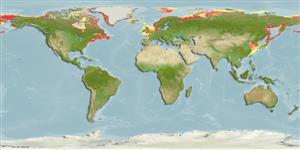Pycnogonida |
Pantopoda |
Nymphonidae
Environment: milieu / climate zone / गहराई सीमा / distribution range
पारिस्थितिकी
; गहराई सीमा 0 - 100 m (संदर्भ 256). Boreal
Northwest Pacific, Arctic and Northern Atlantic.
Length at first maturity / आकार / Weight / Age
परिपक्व अवधि: Lm ? range ? - ? cm
Trunk glabrous, lateral processes separated by intervals equal to diameters, about 1.5 times longer than diameters. Neck moderately long, ocular tubercle wider than tall, eyes large. Proboscis a cylinder tapering distally. Abdomen short, not as long as fourth lateral processes.
Chelifore scapes as long as proboscis, palm rectangular, with many ventral setae, fingers shorter, slender, carried at acute angle, armed with many tiny teeth. Palp second and third segments subequal, fourth very short, fifth about as long as third, distal 2 segments with many short setae. Oviger terminal claw with many tiny teeth. Legs long, slender, tarsus about 1.5 times longer than slender propodus, both with tiny sole spines. Claw slender, slightly less than half propodus length, auxiliaries less than 0.3 main claw length (Ref. 2153, p. 23).
Shelf (Ref. 19). Sublittoral (Ref. 256).
Life cycle and mating behavior
परिपक्व अवधि | पुनरुत्पत्ति | मछलीऔ का अंडे देना | Eggs | Fecundity | Larvae
Members of the class Pycnogonida are gonochoric and sexually dimorphic. During copulation, male usually suspends itself beneath the female. Fertilization occurs as the eggs leave the female's ovigers. Males brood the egg masses until they hatch. Life cycle: Eggs hatch into protonymphon larva then to adults.
King, P.E. 1973 Pycnogonids. Hutchinson of London. London, UK. 144 p. (संदर्भ 12)
IUCN Red List Status
(संदर्भ 130435: Version 2025-1)
CITES status (संदर्भ 108899)
Not Evaluated
CMS (संदर्भ 116361)
Not Evaluated
Threat to humans
Human uses
| FishSource |
साधन
अधिक जानकारी
Trophic EcologyFood items (preys)
संघटक आहार
आहार खपत
परभक्षी
Population dynamicsबाढ़
Max. ages / sizes
Length-weight rel.
Length-length rel.
Length-frequencies
Mass conversion
बहुतायत
Life cycleपुनरुत्पत्तिपरिपक्व अवधिFecundityमछलीऔ का अंडे देनाEggsEgg developmentLarvae PhysiologyOxygen consumption
Human RelatedStamps, coins, misc.
इंटरनेट स्रोत
Estimates based on models
Preferred temperature
(Ref.
115969): 0.4 - 11.5, mean 3 (based on 1310 cells).
Price category
Unknown.
